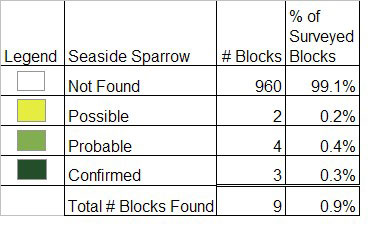Breeding Bird Atlases (BBA)
Find a Bird - BBA1
Breeding Bird Atlas 1 Species Accounts
Seaside Sparrow
Ammodramus maritimus
Egg Dates
May 25 to August 11
Number of Broods
one; may renest if first attempt fails.

The Seaside Sparrow is an uncommon and extremely local summer resident in Massachusetts whose status does not seem to have changed much since the turn of the century. Small but stable populations have long been reported from the salt marshes of the Parker River in Essex County, Barnstable on the Cape, and the Westport area of southeastern Massachusetts, where the first Massachusetts nest was discovered in 1896. Only occasional nestings have been reported elsewhere.
Both the common and scientific names of this sparrow are appropriate because it is rarely seen away from a salt marsh. Although distinctively plumaged, the Seaside Sparrow bears a more than superficial resemblance in other characters to its congener, the Saltmarsh Sharp-tailed Sparrow, which resides in the same coastal habitat. The two species have similar songs, and both are very elusive, sharing behaviors of remaining hidden from view, darting from one clump of grass to the next, and, when forced to fly, making a short, rapid flight that ends by plummeting into the marsh. The Seaside Sparrow has a more southern distribution than the Saltmarsh Sharp-tailed Sparrow, with Massachusetts near its northern limit.
The first residents generally arrive during the first week in May, and by the first week in June pairs are established on territory. The song is a repetitive kreeuk-tzzeee-eee, kreeeuk-tzzzeeeee, with an accent on the zeeee. The second note sounds like it is being exhaled. Another variation is churck-uk-lee. The Seaside Sparrow sometimes vocalizes on the wing but more typically sings while perched on a bush or grass stalk. It is decidedly most vocal at dusk. The call notes are a scolding chip-tip-tip-tip, having the quality of a muted Red-winged Blackbird call. The nest is usually built on the ground in the salt marsh just above the high water mark and is therefore subject to destruction by flooding in storms. Some nests are suspended between salt marsh grass stalks, and, rarely, some are placed in low bushes. In a South Dartmouth marsh, 82 percent of 60 nests found were in Saltwater Cordgrass areas with irregular flooding and 54 percent were in medium-height Saltwater Cordgrass along creek banks. One half of the nests found were destroyed by flood tides (Marshall & Reinert 1990). Four to six grayish eggs, coarsely blotched with reddish brown, are laid in a cup nest made of grasses. The mean clutch size in the South Dartmouth study area was four eggs (range three to five) for 30 nests in 1985 and four eggs (range two to five) for 25 nests in 1986 (Marshall & Reinert 1990). The female incubates for a period of about 12 days, but both adults share in feeding the nestlings, which depart from the nest in 9 to 11 days after hatching. The young are fed for a short period after leaving the nest, crouching low in the grass between visits by the parents. The diet is more varied than the usual fare of sparrows, consisting of tiny crabs, snails, and other marine creatures in addition to the more standard insects and seeds. In Essex County, the period from egg laying to fledging is the first week of June to the second week of August (ECOC). If initial nesting attempts are unsuccessful, renesting occurs, sometimes two or three times in a season. Nesting becomes highly synchronized after a flood tide wipes out the active nests, when rapid renesting allows the cycle to be completed before the next tide (Marshall & Reinert 1990). There is evidence that some dispersal occurs in late summer, from mid-August to September, because there are frequent sightings of individuals in areas away from where they are known to breed. Most of the birds appear to have departed by the end of September or early October, but persistent reports of individuals during winter suggest that a portion of the population attempts to overwinter. Most Seaside Sparrows winter in salt marshes from Virginia to Florida.
Map Legend and Data Summary
Atlas 1 data collected from 1975-1979


Note: rare and local in salt marshes of southeastern region; also at Parker River National Wildlife Refuge
Edward H. Raymond



